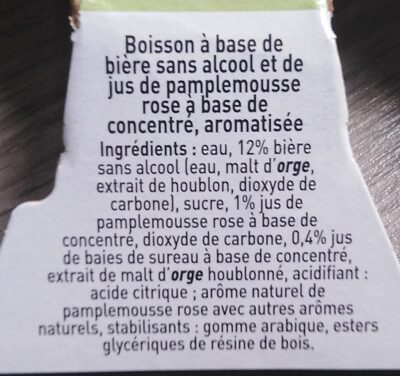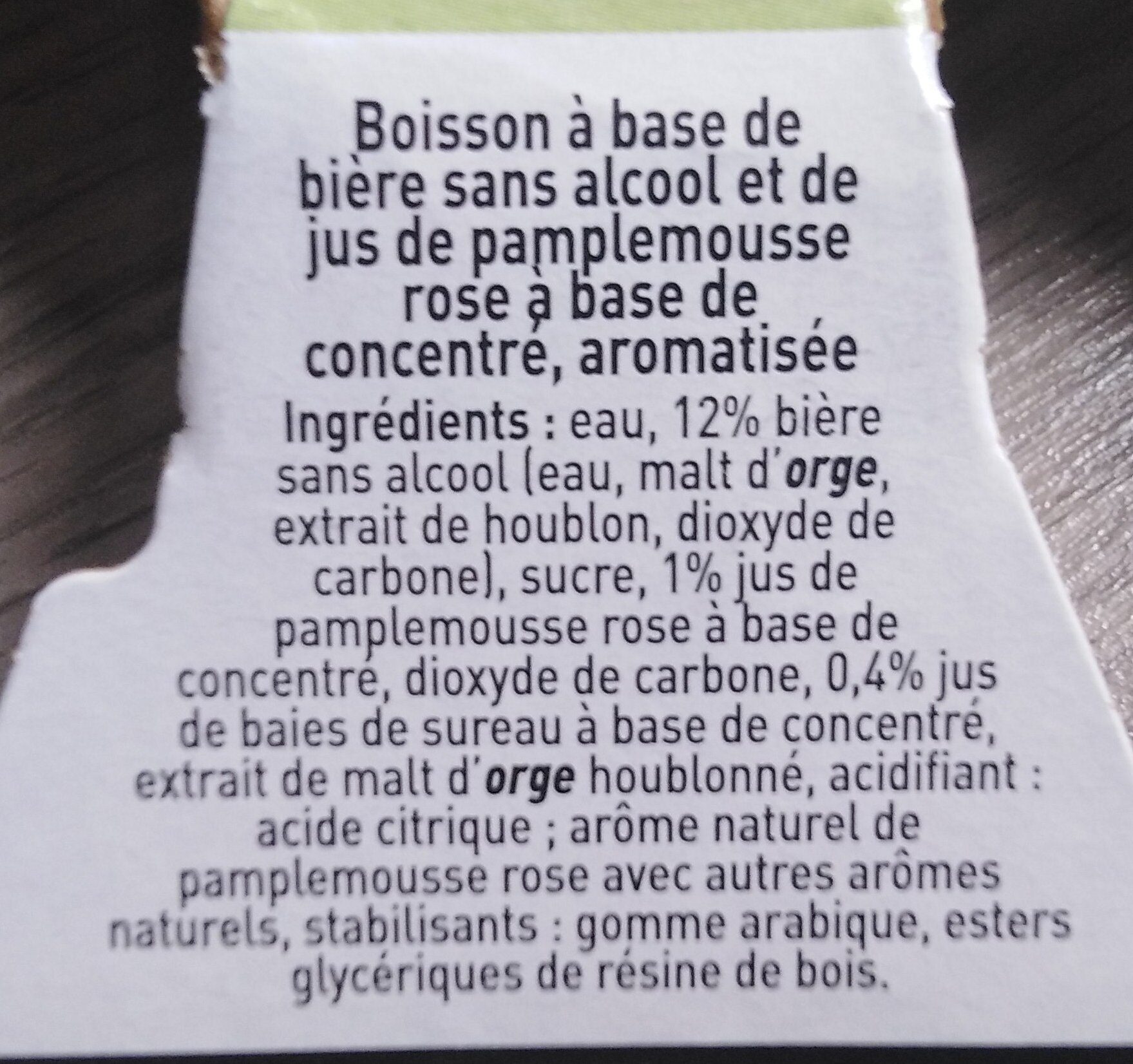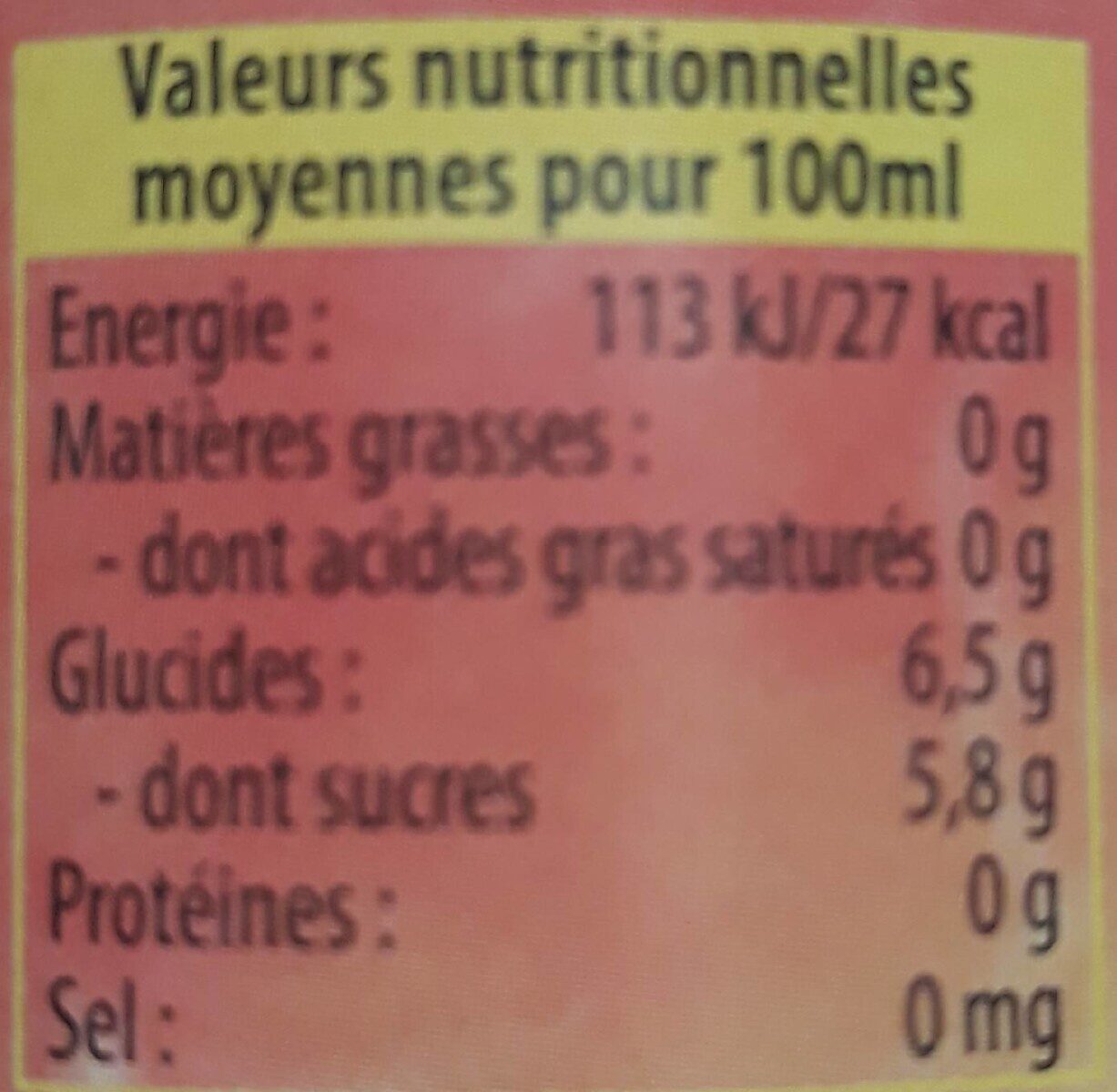Help us make food transparency the norm!
As a non-profit organization, we depend on your donations to continue informing consumers around the world about what they eat.
The food revolution starts with you!
Biere pamplemousse sans alcool - PERLEMBOURG - 6x33cl
Biere pamplemousse sans alcool - PERLEMBOURG - 6x33cl
This product page is not complete. You can help to complete it by editing it and adding more data from the photos we have, or by taking more photos using the app for Android or iPhone/iPad. Thank you!
×
Barcode: 4056489005964 (EAN / EAN-13)
Common name: Biere sans alcool aromatisée pamplemousse rose
Quantity: 6x33cl
Brands: PERLEMBOURG
Categories: Beverages, Alcoholic beverages, Frozen foods, Non-alcoholic beverages, Premixed alcoholic beverages, Beer-based alcoholic beverages, Mixed drinks, Non-alcoholic beers, Shandy, Sweetened beverages
Countries where sold: France
Matching with your preferences
Health
-
Reduce or stop drinking alcohol
Less is better
This might not be the answer people want to hear, but there is no safe level for drinking alcohol. Of course there is lower-risk drinking, but WHO does not set particular limits, because the evidence shows that the ideal situation for health is to not drink at all. Alcohol is closely related to around 60 different diagnoses and for almost all there is a close dose–response relationship, so the more you drink, the higher your risk of disease. Less is better.
Source: World Health Organization (WHO) - Q&A – How can I drink alcohol safely?
Ingredients
-
17 ingredients
: Eau, 12% bière sans alcool (eau, malt d orge, extrait de houblon, dioxyde de carbone), sucre, 1% jus de pamplemousse rose à base de concentré, dioxyde de carbone, 0,4% Jus de baies de sureau à base de concentre extrait de malt d'orge houblonné, acidifiant acide citrique; arôme naturel de pamplemousse rose avec autres arômes naturels, stabilisants: gomme arabique, esters glycériques de résiné de bois.Allergens: Gluten
Food processing
-
Ultra processed foods
Elements that indicate the product is in the 4 - Ultra processed food and drink products group:
- Additive: E290 - Carbon dioxide
- Additive: E414 - Acacia gum
- Additive: E445 - Glycerol esters of wood rosin
- Ingredient: Flavouring
Food products are classified into 4 groups according to their degree of processing:
- Unprocessed or minimally processed foods
- Processed culinary ingredients
- Processed foods
- Ultra processed foods
The determination of the group is based on the category of the product and on the ingredients it contains.
Additives
-
E290 - Carbon dioxide
Carbon dioxide: Carbon dioxide -chemical formula CO2- is a colorless gas with a density about 60% higher than that of dry air. Carbon dioxide consists of a carbon atom covalently double bonded to two oxygen atoms. It occurs naturally in Earth's atmosphere as a trace gas. The current concentration is about 0.04% -410 ppm- by volume, having risen from pre-industrial levels of 280 ppm. Natural sources include volcanoes, hot springs and geysers, and it is freed from carbonate rocks by dissolution in water and acids. Because carbon dioxide is soluble in water, it occurs naturally in groundwater, rivers and lakes, ice caps, glaciers and seawater. It is present in deposits of petroleum and natural gas. Carbon dioxide is odorless at normally encountered concentrations, however, at high concentrations, it has a sharp and acidic odor.As the source of available carbon in the carbon cycle, atmospheric carbon dioxide is the primary carbon source for life on Earth and its concentration in Earth's pre-industrial atmosphere since late in the Precambrian has been regulated by photosynthetic organisms and geological phenomena. Plants, algae and cyanobacteria use light energy to photosynthesize carbohydrate from carbon dioxide and water, with oxygen produced as a waste product.CO2 is produced by all aerobic organisms when they metabolize carbohydrates and lipids to produce energy by respiration. It is returned to water via the gills of fish and to the air via the lungs of air-breathing land animals, including humans. Carbon dioxide is produced during the processes of decay of organic materials and the fermentation of sugars in bread, beer and wine making. It is produced by combustion of wood and other organic materials and fossil fuels such as coal, peat, petroleum and natural gas. It is an unwanted byproduct in many large scale oxidation processes, for example, in the production of acrylic acid -over 5 million tons/year-.It is a versatile industrial material, used, for example, as an inert gas in welding and fire extinguishers, as a pressurizing gas in air guns and oil recovery, as a chemical feedstock and as a supercritical fluid solvent in decaffeination of coffee and supercritical drying. It is added to drinking water and carbonated beverages including beer and sparkling wine to add effervescence. The frozen solid form of CO2, known as dry ice is used as a refrigerant and as an abrasive in dry-ice blasting. Carbon dioxide is the most significant long-lived greenhouse gas in Earth's atmosphere. Since the Industrial Revolution anthropogenic emissions – primarily from use of fossil fuels and deforestation – have rapidly increased its concentration in the atmosphere, leading to global warming. Carbon dioxide also causes ocean acidification because it dissolves in water to form carbonic acid.Source: Wikipedia
-
E330 - Citric acid
Citric acid is a natural organic acid found in citrus fruits such as lemons, oranges, and limes.
It is widely used in the food industry as a flavor enhancer, acidulant, and preservative due to its tart and refreshing taste.
Citric acid is safe for consumption when used in moderation and is considered a generally recognized as safe (GRAS) food additive by regulatory agencies worldwide.
-
E414 - Acacia gum
Gum arabic: Gum arabic, also known as acacia gum, arabic gum, gum acacia, acacia, Senegal gum and Indian gum, and by other names, is a natural gum consisting of the hardened sap of various species of the acacia tree. Originally, gum arabic was collected from Acacia nilotica which was called the "gum arabic tree"; in the present day, gum arabic is collected from acacia species, predominantly Acacia senegal and Vachellia -Acacia- seyal; the term "gum arabic" does not indicate a particular botanical source. In a few cases so‐called "gum arabic" may not even have been collected from Acacia species, but may originate from Combretum, Albizia or some other genus. Producers harvest the gum commercially from wild trees, mostly in Sudan -80%- and throughout the Sahel, from Senegal to Somalia—though it is historically cultivated in Arabia and West Asia. Gum arabic is a complex mixture of glycoproteins and polysaccharides. It is the original source of the sugars arabinose and ribose, both of which were first discovered and isolated from it, and are named after it. Gum arabic is soluble in water. It is edible, and used primarily in the food industry as a stabilizer, with EU E number E414. Gum arabic is a key ingredient in traditional lithography and is used in printing, paint production, glue, cosmetics and various industrial applications, including viscosity control in inks and in textile industries, though less expensive materials compete with it for many of these roles. While gum arabic is now produced throughout the African Sahel, it is still harvested and used in the Middle East.Source: Wikipedia
-
E445 - Glycerol esters of wood rosin
Glycerol ester of wood rosin: Glycerol ester of wood rosin, also known as glyceryl abietate or ester gum, is an oil-soluble food additive -E number E445-. The food-grade material is used in foods, beverages, and cosmetics to keep oils in suspension in water, and its name may be shortened in the ingredient list as glycerol ester of rosin. It is also used as an ingredient in the production of chewing-gum and ice cream. Similar, less pure materials -glycerol ester of gum rosin- are used as a component of certain low-cost adhesives.To make the glycerol ester of wood rosin, refined wood rosin is reacted with glycerin to produce the glycerol ester. Glycerol ester of wood rosin is an alternative to brominated vegetable oil in citrus oil-flavored soft drinks. In some cases, both ingredients are used together.Source: Wikipedia
Ingredients analysis
-
Palm oil free
No ingredients containing palm oil detected
Unrecognized ingredients: fr:biere-sans-alcool, fr:jus-de-baies-de-sureau-a-base-de-concentre-extrait-de-malt-d-orge-houblonneSome ingredients could not be recognized.
We need your help!
You can help us recognize more ingredients and better analyze the list of ingredients for this product and others:
- Edit this product page to correct spelling mistakes in the ingredients list, and/or to remove ingredients in other languages and sentences that are not related to the ingredients.
- Add new entries, synonyms or translations to our multilingual lists of ingredients, ingredient processing methods, and labels.
If you would like to help, join the #ingredients channel on our Slack discussion space and/or learn about ingredients analysis on our wiki. Thank you!
-
Vegan status unknown
Unrecognized ingredients: fr:biere-sans-alcool, fr:jus-de-baies-de-sureau-a-base-de-concentre-extrait-de-malt-d-orge-houblonneSome ingredients could not be recognized.
We need your help!
You can help us recognize more ingredients and better analyze the list of ingredients for this product and others:
- Edit this product page to correct spelling mistakes in the ingredients list, and/or to remove ingredients in other languages and sentences that are not related to the ingredients.
- Add new entries, synonyms or translations to our multilingual lists of ingredients, ingredient processing methods, and labels.
If you would like to help, join the #ingredients channel on our Slack discussion space and/or learn about ingredients analysis on our wiki. Thank you!
-
Vegetarian status unknown
Unrecognized ingredients: fr:biere-sans-alcool, fr:jus-de-baies-de-sureau-a-base-de-concentre-extrait-de-malt-d-orge-houblonneSome ingredients could not be recognized.
We need your help!
You can help us recognize more ingredients and better analyze the list of ingredients for this product and others:
- Edit this product page to correct spelling mistakes in the ingredients list, and/or to remove ingredients in other languages and sentences that are not related to the ingredients.
- Add new entries, synonyms or translations to our multilingual lists of ingredients, ingredient processing methods, and labels.
If you would like to help, join the #ingredients channel on our Slack discussion space and/or learn about ingredients analysis on our wiki. Thank you!
-
Details of the analysis of the ingredients
We need your help!
Some ingredients could not be recognized.
We need your help!
You can help us recognize more ingredients and better analyze the list of ingredients for this product and others:
- Edit this product page to correct spelling mistakes in the ingredients list, and/or to remove ingredients in other languages and sentences that are not related to the ingredients.
- Add new entries, synonyms or translations to our multilingual lists of ingredients, ingredient processing methods, and labels.
If you would like to help, join the #ingredients channel on our Slack discussion space and/or learn about ingredients analysis on our wiki. Thank you!
: Eau, bière sans alcool 12% (eau, malt d orge, extrait de houblon, dioxyde de carbone), sucre, jus de pamplemousse rose à base de concentré 1%, dioxyde de carbone, Jus de baies de sureau à base de concentre extrait de malt d'orge houblonné 0.4%, acidifiant (acide citrique), arôme naturel de pamplemousse rose, arômes naturels, stabilisants (gomme arabique), esters glycériques de résiné de bois- Eau -> en:water - vegan: yes - vegetarian: yes - ciqual_food_code: 18066 - percent_min: 77.8 - percent_max: 85.2
- bière sans alcool -> fr:biere-sans-alcool - percent_min: 12 - percent: 12 - percent_max: 12
- eau -> en:water - vegan: yes - vegetarian: yes - ciqual_food_code: 18066 - percent_min: 3 - percent_max: 12
- malt d orge -> en:malted-barley - vegan: yes - vegetarian: yes - percent_min: 0 - percent_max: 6
- extrait de houblon -> en:hop-extract - vegan: yes - vegetarian: yes - percent_min: 0 - percent_max: 4
- dioxyde de carbone -> en:e290 - vegan: yes - vegetarian: yes - percent_min: 0 - percent_max: 3
- sucre -> en:sugar - vegan: yes - vegetarian: yes - ciqual_proxy_food_code: 31016 - percent_min: 1 - percent_max: 5.8
- jus de pamplemousse rose à base de concentré -> en:pink-grapefruit-juice-from-concentrate - vegan: yes - vegetarian: yes - ciqual_food_code: 13180 - percent_min: 1 - percent: 1 - percent_max: 1
- dioxyde de carbone -> en:e290 - vegan: yes - vegetarian: yes - percent_min: 0.4 - percent_max: 1
- Jus de baies de sureau à base de concentre extrait de malt d'orge houblonné -> fr:jus-de-baies-de-sureau-a-base-de-concentre-extrait-de-malt-d-orge-houblonne - percent_min: 0.4 - percent: 0.4 - percent_max: 0.4
- acidifiant -> en:acid - percent_min: 0 - percent_max: 0.4
- acide citrique -> en:e330 - vegan: yes - vegetarian: yes - percent_min: 0 - percent_max: 0.4
- arôme naturel de pamplemousse rose -> en:pink-grapefruit-natural-flavouring - vegan: maybe - vegetarian: maybe - percent_min: 0 - percent_max: 0.4
- arômes naturels -> en:natural-flavouring - vegan: maybe - vegetarian: maybe - percent_min: 0 - percent_max: 0.4
- stabilisants -> en:stabiliser - percent_min: 0 - percent_max: 0.4
- gomme arabique -> en:e414 - vegan: yes - vegetarian: yes - percent_min: 0 - percent_max: 0.4
- esters glycériques de résiné de bois -> en:e445 - vegan: yes - vegetarian: yes - percent_min: 0 - percent_max: 0.4
Nutrition
-
Nutri-Score not-applicable
Not-applicable for the category: Alcoholic beverages
⚠ ️Nutri-Score not applicable for this product category.Could you add the information needed to compute the Nutri-Score?
-
Nutrition facts
Nutrition facts As sold
for 100 g / 100 mlCompared to: Shandy Energy 114 kj
(27 kcal)-20% Fat 0 g -100% Saturated fat 0 g -100% Carbohydrates 6.55 g -3% Sugars 5.8 g +12% Fiber - Proteins 0 g -100% Salt 0 g -100% Fruits‚ vegetables‚ nuts and rapeseed‚ walnut and olive oils (estimate from ingredients list analysis) 1 %
Environment
-
Eco-Score C - Moderate environmental impact
⚠ ️Select a country in order to include the full impact of transportation.The Eco-Score is an experimental score that summarizes the environmental impacts of food products.→ The Eco-Score was initially developped for France and it is being extended to other European countries. The Eco-Score formula is subject to change as it is regularly improved to make it more precise and better suited to each country.Life cycle analysis
-
Average impact of products of the same category: C (Score: 58/100)
Category: Shandy (beer + lemonade)
Category: Shandy (beer + lemonade)
- PEF environmental score: 0.12 (the lower the score, the lower the impact)
- including impact on climate change: 1.00 kg CO2 eq/kg of product
Stage Impact Agriculture
15.1 %Processing
13.7 %Packaging
43.0 %Transportation
18.5 %Distribution
7.6 %Consumption
2.1 %
Bonuses and maluses
-
Missing origins of ingredients information
Malus: -5
⚠ ️ The origins of the ingredients of this product are not indicated.
If they are indicated on the packaging, you can modify the product sheet and add them.
If you are the manufacturer of this product, you can send us the information with our free platform for producers.
-
Packaging with a low impact
Malus: -3
Shape Material Recycling Impact 1 Sleeve Cardboard Recycle Low 6 Bottle Green Glass Recycle Low 6 Capsule Steel Recycle Low
Eco-Score for this product
-
Impact for this product: C (Score: 50/100)
Product: Biere pamplemousse sans alcool - PERLEMBOURG - 6x33cl
Life cycle analysis score: 58
Sum of bonuses and maluses: -8
Final score: 50/100
-
Carbon footprint
-
Equal to driving 0.5 km in a petrol car
100 g CO² per 100g of product
The carbon emission figure comes from ADEME's Agribalyse database, for the category: Shandy (beer + lemonade) (Source: ADEME Agribalyse Database)
Stage Impact Agriculture
6.5 %Processing
13.9 %Packaging
47.8 %Transportation
27.6 %Distribution
3.5 %Consumption
0.7 %
Packaging
-
Packaging with a low impact
-
Packaging parts
1 x Sleeve (Cardboard: 35.14 g)
6 x Bottle 33cl (Green Glass: 223 g)
6 x Capsule (Steel: 2 g)
-
Packaging materials
Material % Packaging weight Packaging weight per 100 g of product Paper or cardboard 2.5% 35.14 g 1.8 g Glass 96.6% 1338 g 67.6 g Metal 0.9% 12 g 0.6 g Total 100% 1385.14 g 70 g
-
Transportation
-
Origins of ingredients
Missing origins of ingredients information
⚠ ️ The origins of the ingredients of this product are not indicated.
If they are indicated on the packaging, you can modify the product sheet and add them.
If you are the manufacturer of this product, you can send us the information with our free platform for producers.Add the origins of ingredients for this product Add the origins of ingredients for this product
Report a problem
-
Incomplete or incorrect information?
Category, labels, ingredients, allergens, nutritional information, photos etc.
If the information does not match the information on the packaging, please complete or correct it. Open Food Facts is a collaborative database, and every contribution is useful for all.
Data sources
Product added on by kiliweb
Last edit of product page on by roboto-app.
Product page also edited by alexg, desan, openfoodfacts-contributors, quechoisir, yuka.UnF3UENZOWJoS01Ydi9JMS9USHgrT2g2NUs2VGZVYnZCL01hSVE9PQ, yuka.ZlBFSE40MWZpdUVibFBRVDdrL3lwczVNK2EydGZFYTJDL0lmSVE9PQ, yuka.sY2b0xO6T85zoF3NwEKvlhIbet_9m2rBBSzWm0muw-6gAozvW9dX2LTEI6s.










